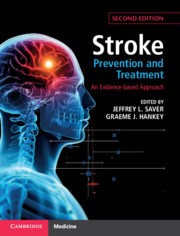Book contents
- Stroke Prevention and Treatment
- Stroke Prevention and Treatment
- Copyright page
- Dedication
- Contents
- Contributors
- Preface
- Part I Foundations
- Part II Systems of Care
- Part III Acute Treatment of Ischaemic Stroke and Transient Ischaemic Attack
- Part IV Acute Treatment of Haemorrhagic Stroke
- Part V Prevention
- Chapter 15 Prevention of Stroke by Lowering Blood Pressure
- Chapter 16 Prevention of Stroke by Lowering Blood Cholesterol Concentrations
- Chapter 17 Prevention of Stroke by Modification of Additional Vascular and Lifestyle Risk Factors
- Chapter 18 Drugs, Devices, and Procedural Therapies to Prevent Recurrent Cardiogenic Embolic Stroke
- Chapter 19 Long-term Antithrombotic Therapy for Large and Small Artery Occlusive Disease
- Chapter 20 Carotid and Vertebral Artery Revascularization
- Chapter 21 Cervical Artery Dissection and Cerebral Vasculitis
- Chapter 22 Prevention of Intracerebral and Subarachnoid Haemorrhage
- Part VI Stroke Rehabilitation and Recovery
- Index
- References
Chapter 18 - Drugs, Devices, and Procedural Therapies to Prevent Recurrent Cardiogenic Embolic Stroke
from Part V - Prevention
Published online by Cambridge University Press: 15 December 2020
- Stroke Prevention and Treatment
- Stroke Prevention and Treatment
- Copyright page
- Dedication
- Contents
- Contributors
- Preface
- Part I Foundations
- Part II Systems of Care
- Part III Acute Treatment of Ischaemic Stroke and Transient Ischaemic Attack
- Part IV Acute Treatment of Haemorrhagic Stroke
- Part V Prevention
- Chapter 15 Prevention of Stroke by Lowering Blood Pressure
- Chapter 16 Prevention of Stroke by Lowering Blood Cholesterol Concentrations
- Chapter 17 Prevention of Stroke by Modification of Additional Vascular and Lifestyle Risk Factors
- Chapter 18 Drugs, Devices, and Procedural Therapies to Prevent Recurrent Cardiogenic Embolic Stroke
- Chapter 19 Long-term Antithrombotic Therapy for Large and Small Artery Occlusive Disease
- Chapter 20 Carotid and Vertebral Artery Revascularization
- Chapter 21 Cervical Artery Dissection and Cerebral Vasculitis
- Chapter 22 Prevention of Intracerebral and Subarachnoid Haemorrhage
- Part VI Stroke Rehabilitation and Recovery
- Index
- References
Summary
Cardiogenic embolism is a common cause of recurrent ischaemic stroke. The cardiac source of embolism is usually the left atrial appendage and atrium due to atrial fibrillation (AF). Other sources include the left ventricle, heart valves and venous system or right atrium, via a patent foramen ovale.The most effective thromboprophylactic is oral anticoagulation, which reduces the risk of recurrent stroke by about two thirds, compared to no anticoagulation. Four target-specific, direct-acting non-vitamin K antagonist oral anticoagulants (NOACs) – the direct thrombin inhibitor dabigatran etexilate, and the factor Xa inhibitors rivaroxaban, apixaban and edoxaban – are at least as efficacious and safe as warfarin, and apixaban is superior to, and as safe as, aspirin, for preventing stroke among patients with AF. Other potential stroke prevention strategies include left atrial appendage occlusion for patients with AF in whom anticoagulation is contraindicated, anticoagulation for left ventricular thrombus and prosthetic heart valves, antibiotics +/– valve surgery for infective endocarditis, and transcatheter device closure of a symptomatic patent foramen ovale.
Keywords
- Type
- Chapter
- Information
- Stroke Prevention and TreatmentAn Evidence-based Approach, pp. 337 - 383Publisher: Cambridge University PressPrint publication year: 2020



